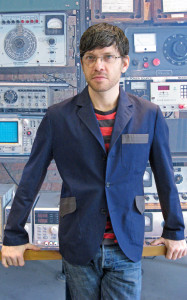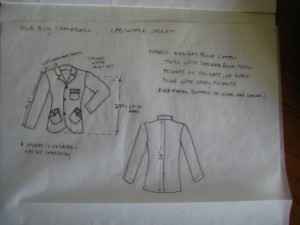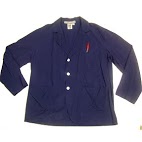Rob Roy Mackinnon Campbell
Uniform Essay
by Rob Roy Mackinnon Campbell
For most of my adult life I’ve proclaimed a dismissive indifference toward fashion, insisting that I don’t have time to think about it and don’t value it enough to prioritize it. Even when I was a young self-identified punk rocker with a record label, I was never the kid with the mohawk — I was the kid wearing thrift-store clothes without managing to achieve the fashionable irony that’s supposed to accompany white suburban kids who wear thrift-store clothes.
Indeed, a sizable chunk of my punk ethos manifested itself as a stance against fashion — a non-conformist ideology stipulating that fashion should not define my place in a social hierarchy, with the belief that I would be judged not by the style of my clothes but by the content of my character.
How naive I was!
I’ve long since accepted the fact that fashion is so deeply rooted in the human psyche that it wields enormous power and influence over people with otherwise rational minds. It somehow has the ability to cause friendship between people with nothing in common, and disdain between people who might otherwise be friends. Fashion can be the difference between getting high-fived or heckled by a group of intoxicated sports fans, and it can even make people you’ve known for years act that they don’t know who you are!
Despite all these unfortunate side-effects, I’ve come to not only accept fashion’s place in society, but also it’s place in my life. Specifically, I’ve learned to accept and exploit the affect it has on my state of mind.
In my profession, I specialize in a field of technology that was considered cutting edge probably sometime during the mid nineteen fifties; a practice that had long since died out by the time I was born in 1972. The superstars of my field of study weren’t casual jeans and turtle-neck wearing Silicon Valley types — that fashion didn’t take over the technology sector until Steve Jobs made it famous in the mid 1990′s. My superheros worked in electronics laboratories and wore ties and white dress shirts tucked into black pants, which were sometimes held up with suspenders. Horn rimmed glasses were on their first tour of the fashion circuit, not yet having been brought back to life by hipsters and pseudo-nerds who would eventually claim ownership of once-derogatory terms like “nerd” or “geek”.
In my vast collection of early 20th century electronics books, photos of scientists, mathematicians, and engineers abound, and nary an instance is any of them underdressed. Whether working in a clean-room laboratory environment, a busy manufacturing facility, or a professional recording studio, a decidedly fashionable attire was employed to show the laymen that these were specialists who commanded respect; a respect earned only through the mastery of a craft or advanced skill-set. As such, the particular attire worn by people of various skill levels was either worn with pride or shame, as apprentices strove to shed their novice suits for the master’s garb.
Independent inventors were somewhat exempt from this hierarchical fashion mandate, which left it up to personal taste, with sometimes wonderful and sometimes disastrous results. Thomas Edison, for example, was known for his total obliviousness not only to decent attire but to basic personal hygiene as well, which meant that this famous American capitalist was a disgusting smelly slob most of the time. On the contrary, the scientific genius Nikola Tesla was a sharp and meticulous dresser, who in nearly every photograph, candid or staged, managed to portray a handsome aire of sophistication and intrigue that was a perfect match for his intellect. The fact that Edison’s career was dominated by disgusting behavior and business practices, while Tesla left behind a legacy of creativity and brilliance, and that these two things were symbolized by their individual fashion choices, is intriguing to such an extent that I can’t help but ask myself: what does my fashion say about me?
After reflecting on this for a minute one thing became clear: my fashion includes all kinds of embellishments, but they’re usually embellishments that only I am aware of. For example, my sock drawer is filled with plain black socks, but among them is a prized pair of bright orange and turquoise striped socks that I save for special occasions. A special occasion could be anything: date night with my fiancée, a sunny day after a stretch of overcast skies, or even a celebration of a particularly delicious cup of coffee that morning. I also have a few prized pairs of underwear too, but I won’t get into that. Let’s just say that underneath the inconspicuous outer layer, there’s a party going on!
My special-occasion socks seem to infuse into my mood a little extra playfulness, and a loftier expectation that the day is going to turn out great. I’ll even admit that there have even been days that started out bad, and my remedy has been to change my clothes. For whatever reason, it seems to work!
So despite years of skepticism, I’ve reached a point where I can enthusiastically accept the role that fashion plays in my life. I’m still grateful for the years of skepticism because they have ensured that I would never care enough about fashion to become stressed out about getting it wrong, which means I am free to harvest all the potential power of it not for the sake of social acceptance and hierarchy, but for the benefit of my own personal state of mind. Simply stated, fashion is a tool that we’re all free to use however we like, and it’s a tool that I’m happy to have in my toolbox!
Bio Rob Roy M. Campbell is a Chicago-based musician, audio equipment designer, and owner of Electronaut Company.



